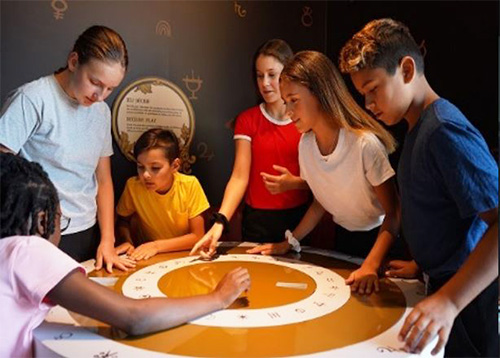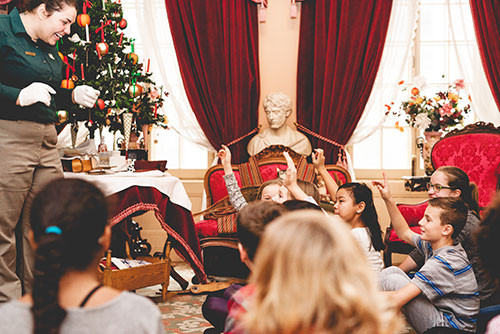
School programs
Sir George-Étienne Cartier National Historic Site
Located in Montreal, Sir George-Étienne Cartier National Historic Site is the perfect place to understand the birth of modern Canada and the 19th-century bourgeoisie.
Introduce students of different grade levels to educational programs and activities to be held on site or in the classroom.
These programs bring social studies concepts to life in a stimulating learning environment.
Classroom activities: Free online workshops hosted by École en réseau
Parks Canada is pleased to partner with École en réseau to present free online workshops all year long. These workshops are intended for elementary school students in cycles 1, 2 and 3, as well as high school students.
They cover different themes as history, outdoors and conservation.
For the complete program and to register, visit École en réseau. * Please note that English workshops are listed after the French version on the website.
The day before each presentation, those who have signed up will receive an email with a link to join the workshop.
All presentations will be recorded and can be viewed after the original presentation date using a link provided to those that registered for the presentation.
On-site activity: “Dream into action!” guided tour

Suggested content: Sir George-Étienne Cartier is an actor of change and a reformist politician who is key to Canada’s history. In Cartier’s home, students explore a country under construction and a bourgeois house. They experience the Canadian political system and the notion of civic involvement through interactive games, discussions and reflections.
Target group: Elementary school students (3rd cycle):
Languages:
- French
- English
Length of visit: 2 hours divided into two activities of around 50 minutes each
Dates: available in September, October, November, December, April, May and June
Fees: See costs per student
On-site activity: “A Victorian Christmas” guided tour

Suggested content: Enter the magical world of Christmas in the home of a prosperous 19th century family and witness the final festive preparations!
Target group: Elementary school students (3rd cycle):
Languages:
- French
- English
Length of visit: 90 minutes
Dates: available in November and December
Fees: See costs per student
French-language Learning Groups
See Group activities.
Reservations and information
cartier@pc.gc.ca
514-283-2282
1-888-773-8888
Please note that there is a bus drop-off area and that it is possible for the group to have lunch on site (students must bring a lunch, as there is no catering service).
Financial support
Experiences offered by Parks Canada are part of the culture and education resource directory (in French only). Financial support from the Government of Québec could be provided. For further information, please refer to the ministère de l’Éducation et de l’Enseignement supérieur Website or contact your school administration.
To prepare for your visit to Sir-George-Étienne-Cartier National Historic Site:
Watch the State of Play video with your students.
A short animation video introduces George-Étienne Cartier and reviews the main historic milestones leading to Confederation.
Duration: 15 minutes.
Watch or download the video
State of Play
Transcript
Parks Canada logo
[Narrator] Welcome to George-Étienne Cartier's home. You are currently standing in the house he acquired in 1848. That same year, he was elected for the first time to the United Province of Canada Legislative Assembly. Who was Cartier? What was the United Province of Canada? To answer these questions, let's go back to the dawn of Canadian history. Arriving by Beringia, the original inhabitants of the continent had been there since time immemorial. In 1534, the Frenchman Jacques Cartier landed in Gaspé. He planted a cross and claimed the territory of New France in the name of his king.
[Jacques Cartier is standing in front of three Indigenous people.Four questions are written: During which century did he live? Where was he from? What was his trade? Was he related to George-Étienne Cartier?]
In 1608, Samuel de Champlain founded Quebec City Little by little, colonists settled in New France along the St. Lawrence valley. The monarchist system was established in the colony. The King of France, the supreme authority, appointed a governor to direct the Colony and represent him in front of his subjects.
[Settlers are raising New France flags over their houses. Three questions are written: What is the definition of a colony? Which country governs New France? Can settlers vote?]
In 1759, while New France had 70 000 inhabitants, the British army conquered Quebec City. In 1760, they took hold of Montreal. France ceded the territory and the Treaty of Paris was signed in 1763.
[Settlers are replacing New France flags by British flags. Two questions are written: Which country rules the colony? Can settlers now vote?]
Despite themselves, the French subjects became British subjects while the Indigenous peoples were ignored in the agreement. The Canadian colony was then named the Province of Quebec Over time, a few British colonists settled in the colony. Soon after, the United States became a republic which was henceforth independent of the British empire. Loyalists, who were attached to the Crown, fled and settled in the Province of Quebec. In 1791, in order to satisfy the growing British population who desired a political voice, the British government split the Province of Quebec into two parts: Upper and Lower Canada.
[A map of Upper and Lower Canada is shown. Three questions are written: Today, which provinces correspond to Upper and to Lower Canada? What are the main spoken langages in these provinces? What is the name of the place where laws are discussed, negociated and passed?]
The first parliamentary institutions in the country, which excluded women and Indigenous peoples, were emerging at this time. In both provinces, certain subjects voted to elect members of the House of Assembly. The elected members were responsible for looking after the interests of their constituents in front of the governor who was chosen by Great Britain. Therefore, real power remained in the hands of the governor and his entourage, who decided upon the laws and managed the budget.
[The governor is sitting at a table with his entourage. Two question are written: Is the Governor elected by the population? Do you think this system is fair?]
Dissatisfaction ensued. The people were critical of the governor's favouritism towards the Anglophone minority. The members of the Lower Canada House of Assembly tried to convince the British government to transfer some of the governor's power to the houses of assembly elected by the people. They proposed 92 resolutions to make Canadian political institutions more democratic. The British Government rejected most of the petitions. Revolt was simmering. Armed insurgencies against the Crown escalated into bloody battles. Known as the Rebellion in Lower Canada, this revolt would be severely suppressed by the British army. This is when Lord Durham comes into play. This new governor was charged with producing a report on the causes that led to the rebellion. Among other things, Durham recommended the unification of Upper and Lower Canada to reduce the political and demographic weight of the french canadian population. In 1840 the Union Act formalized the forced union of the two colonies. The new United Province of Canada now had only one legislative assembly. In 1848, the British government granted more power to the Assembly by creating responsible government. From that moment on, the population who had the right to vote, elected the members of the Assembly who in turn chose their leader. This was a great step in the history of Canadian democracy. It was at this time that George-Étienne Cartier began his active political career. He was elected Member of Parliament in the County of Verchères.
[George-Étienne Cartier is standing in front of the Parliament. Two questions are written: What is the definition of a deputy? What takes place at a Parliament?
At that time, the United Province of Canada Legislative was dominated by political parties with divergent ideas and allegiances: French Canadians, Anglophones, monarchists, republicans, Catholics, Protestants. These differences led to a succession of short-lived minority governments. But in 1867, several men with divergent political ideas agreed on the foundations leading to Canadian confederation. Among them was George-Étienne Cartier. We invite you to enter his home to discover how economic issues, backstairs influences and the political manoeuvres of his era helped shape the Canada of today.
[A portrait of George-Étienne Cartier is shown. Biographical informations are written on the screen.]
[Then a picture of the Fathers of the Confederation is shown with the date 1867. Two questions are written : What happened in 1867? Can you find George-Étienne Cartier and John A. Macdonald in this picture?]
Parks Canada logo.
Copyright Her Majesty the Queen in Right of Canada, represented by Parks Canada, 2019.
Canada wordmark.
Check out the interactive learning guide for Sir George-Étienne Cartier National Historic Site.

A fun and interactive document introduces the key concepts of the visit. Students read actively and rise to different challenges.
Public: Elementary - 3rd cycle.
Duration: 30 minutes.
Download the dynamic version (Computers only)
- Download the file. (PDF, 8,6 Mo).
- Open the file with Google Chrome (free).You can also open it using Adobe Acrobat Reader DC (free).
To read the document on a smartphone or a tablet, please use the static version.
Download the static version (All supports)
Related links
- Date modified :